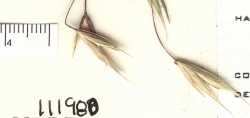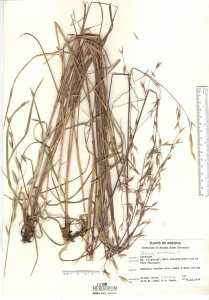Plants annual. Culms 80-110 cm, erect. Lower sheaths densely, softly appressed-hairy; ligules 1-1.5 mm, hairy, obtuse, erose; blades 10-20 cm long, 2-6 mm wide, coarsely pilose on both surfaces. Panicles 11-30 cm long, 4-20 cm wide, open, erect or nodding; branches usually longer than the spikelets, ascending to widely spreading, slender, slightly curved or straight. Spikelets 10-25 mm, lanceolate, terete to moderately laterally compressed, often purple-tinged; florets 4-10, bases concealed or visible at maturity; rachilla internodes concealed or visible at maturity. Glumes glabrous; lower glumes 4-6 mm, 3-veined; upper glumes 5-8 mm, 5-veined; lemmas 7-9 mm long, 1.1-1.5 mm wide, lanceolate, obscurely 7-veined, rounded over the midvein, glabrous, coriaceous, margins slightly angled, inrolled or not at maturity, apices acute, bifid, teeth shorter than 1 mm; awns 6-11 mm, straight, arising at varying distances below the lemma apices; anthers 2.5-5 mm. Caryopses shorter than the paleas, weakly to strongly inrolled. 2n = 14.
Bromus arvensis grows along roadsides and in fields and waste places. It is native to southern and south-central Europe.
Common Name: field brome
Duration: Annual
Nativity: Non-Native
Lifeform: Graminoid
General: Annual with erect stems 8-110 cm, often geniculate, lower sheaths densely hairy with soft appressed hairs.
Vegetative: Blades coarsely pilose on both surfaces 10-20 cm long, 2-6 mm wide, ligules membranous, erose ciliolate, 0.5-1.5 mm.
Inflorescence: Open, erect to nodding panicle 11-30 cm long, 4-20 cm wide, branches usually longer than the spikelets, ascending to widely spreading, slender, curved to straight with spikelets 10-25 mm, lanceolate, terete to moderately laterally compressed, often purple tinged with 4-10 florets, the bases concealed to visible at maturity; glumes glabrous, subequal, lower 4-6 mm, 3-veined, upper 5-8 mm, 5-veined; lemmas 7-9 mm long, 1-1.5 mm wide, lanceolate, obscurely 7-veined, rounded over midvein, margins slightly angled, apices acute, bifid, teeth shorter than 1 mm; awns 6-11 mm, straight, arising at varying distances below the lemma apices.
Ecology: Found in disturbed areas from 4,500-7,500 ft (1372-2286 m); flowers May-September.
Notes: There is a little uncertainty as to the identity of this species. FNA still indicates that B. arvensis and B. japonicus are segregate taxa, but Tropicos indicates they are not separate. B. japonicus is a more widespread species, but morphologically there are precious little differences. FNA indicates few more florets, shorter leaf blades, and slightly smaller panicles. These species are treated as one here.
Ethnobotany: Unknown
Etymology: Bromus is from Greek bromo, for stinking, while arvensis means of the fields.
Synonyms: Bromus japonicus
Editor: SBuckley, 2010
Annual 3-10 dm, the culms glabrous; sheaths with scattered hairs; blades 10-20 cm נ2-6 mm, flat, sparsely hairy; panicle 15-30 cm, erect or eventually nodding, with long, slender, ascending to suberect branches; spikelets 10-25 mm, 4-10-fld; first glume 4-6 mm, 3(5)-veined, the second 6-8 mm, 5- or 7-veined; lemmas 7-9 mm, with a straight awn 6-10 mm; palea about equaling the lemma; anthers (3-)4-5 mm; 2n=14. Native of s. Europe, sparingly intr. in our range and elsewhere in the U.S.
Gleason, Henry A. & Cronquist, Arthur J. 1991. Manual of vascular plants of northeastern United States and adjacent Canada. lxxv + 910 pp.
©The New York Botanical Garden. All rights reserved. Used by permission.













